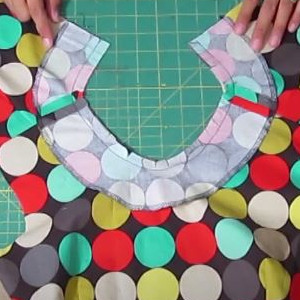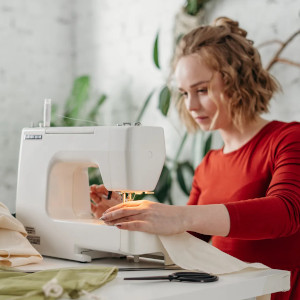After all the hard work of cutting and sewing with your machine, if you think that your project is complete, you are not correct. A lot of work is still pending. A quality stitching on an outfit is not perfect until and unless you have given it its necessary finishing touches.
The overall look of any outfit or other household materials cannot be said as a complete one until it is ready. The whole process of sewing a cloth goes through an entire lengthy process. Starting from designing, drafting, cutting, seaming, hemming, layering, facing, and ultimately pressing.
What Is Facing In Sewing
 A lot of dressmakers at beginner’s level seem to be unaware of what is facing in sewing? To clear the air, when a part of a fabric used in the actual garment covers the raw and open edges for a finishing touch, the process is known as facing. A facing piece for cloth sliced in the same way as the outfit, it meets and hangs on in the same way.
A lot of dressmakers at beginner’s level seem to be unaware of what is facing in sewing? To clear the air, when a part of a fabric used in the actual garment covers the raw and open edges for a finishing touch, the process is known as facing. A facing piece for cloth sliced in the same way as the outfit, it meets and hangs on in the same way.
The common areas where facing is useful are:
- Necklines without collar
- Armholes
- Waistlines
- Hems
- Openings
- Quilts
- Curtain hems
Techniques Of Sewing A Facing On A Fabric
 The use of facing on any outfit or garment gives it a clean finish. The techniques of facing falls under three categories. Each of them is as below:
The use of facing on any outfit or garment gives it a clean finish. The techniques of facing falls under three categories. Each of them is as below:
Shaped Facing Technique
The cut fabric pieces of this process are of the same shape as the outer fabric or the actual fabric. The cut made is precisely in the same pattern. The fabric can either be of the same material or any other cloth lighter than the actual fabric. Some tailors also use the color of a different but similar shade. It also adds as a decorative embellishment on the garment.
Read More: How to sew terry cloth edge
Procedure:
- Step 1: Cut the fabric in the same pattern.
- Step 2: Apply the interfacing to the facing piece.
- Step 3: Sew the neckline (on both front and back parts).
- Step 4: Stitch it together with shoulder seams.
- Step 5: Stitch it to the garment.
Another process is by sewing the facing at the side seams and not on the shoulder seams. Match and align the right sides of both the lining and the actual fabric. Then stitch it along the edges of armholes and necklines. Face it towards you while sewing and secure with pins, so that no disturbance displaces its position. After completing, turn it inside out and iron it.
It is advisable to place both sides of facing and garment together. For under-stitching, press the seam allowance and then stitch it up.
Extended Facing Technique
This process is more straightforward than shaped facings. Here, the extensions of the garment require folding. The tailor then wraps the expansion towards the backside and along the edges and then sewn. The procedure is as follows:
- Step 1: Cut the fabric for facing.
- Step 2: Trim the extra portion of the seam. Facing must be narrow than the seam allowance.
- Step 3: Secure it up with pins.
- Step 4: Turn facing inside and iron it.
- Step 5: Under stitch wherever possible.
- Step 6: Align the facing with the folded line and match the edges.
- Step 7: Stitch along the neckline.
- Step 8: Re-stitch near the edge.
Extended facings are useful in garments with openings.
Bias Facing Technique
The facings here are cut in thin strips of lightweight fabrics and given a shape to match the edge of the actual garment. These are used in sheer fabrics or see-through materials to avoid transparency and in children’s clothing as well. The method involves:
- Step 1: Cut the fabric but twice the length of the fabric area that needs facing. It will also include space for seam allowance.
- Step 2: Hold the wrong sides together
- Step 3: Fold it in half
- Step 4: Iron it on top to provide it with a shape.
- Step 5: Baste the strip over the garment that needs facing.
- Step 6: Stitch it up.
- Step 7: Ease and stretch the inner and outer curves, respectively.
- Step 8: Trim the facing narrow than the garment allowance.
- Step 9: Clip the inner curve along the seam.
- Step 10: Turn and under-stitch
- Step 11: Slip-stitch the edge facing the inside.
Facing In Sewing: Tips And Tricks
 Every facing user must also remember a few tips that will make the process easier while sewing.
Every facing user must also remember a few tips that will make the process easier while sewing.
- Facings must preferably be lighter than the garment.
- The pattern of stitches should be the same.
- Do not put the substantial edges on the same side as the edge of the facing.
- Buttonholes require facing as well.
- Use clip or pins for inward and outer curves.
- Use slip-stitch so that the facing stays inside the garment.
- Under-stitch is necessary to prevent curling up to the outer side.
- To add a finishing touch, sew the necklines too.
Apply the techniques of facings in your next design and achieve a professional look. Preserve the patterns for future use; you never know which model of the same you may suddenly require, especially for similar products. Facings also prevent fraying of threads. It also helps in giving support to the garment and retains its shape. The interfacing also prevents undesirable stretching and sagging of necklines or sleeves. While preparing the interfacing, the fabric should be of the same size.
What Is Facing In Sewing: Final Thoughts
Remember to use a matching lining piece or the same fabric to sew transparently or see-through materials. Use a hot iron for pressing. It will allow the facing to stay in place. Thus, next time you sew an outfit or see-through fabrics or any other household materials that may require support, use a lining to prevent fraying and transparency in some and a finishing and decorative edge in other cases, as and when needed.
Before you apply a facing on the garment, use a trial on a scrap piece to get an idea about the same. Do not get disheartened if you could not achieve the correct result in the first go itself; things will become more evident in due course of time with practice and experience.



